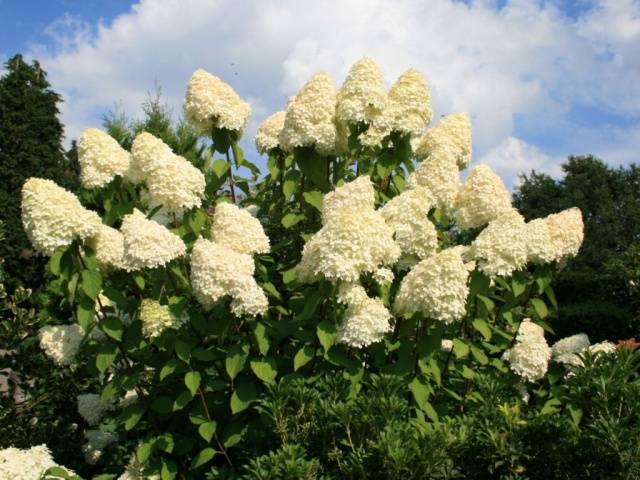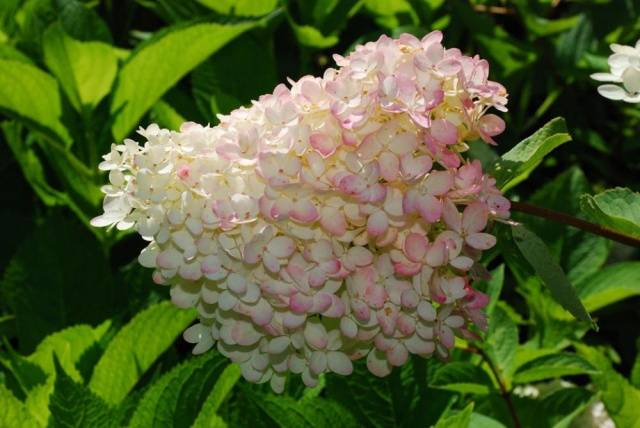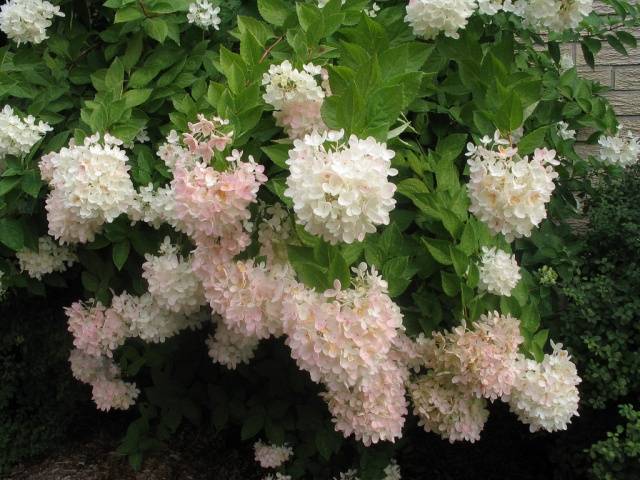Content
Ornamental shrubs are valued for their spectacular appearance and unpretentiousness. The panicle hydrangea has been cultivated since the 19th century. In nature, the plant is found in Asia. Grandiflora is the most famous hydrangea variety that has gained popularity among gardeners around the world. Below is a detailed description and photo of the Grandiflora panicle hydrangea.
Botanical description
Hydrangea Grandiflora is a shrub up to 2 m high with decorative properties. The root system is located at the surface of the earth. The crown is spherical, reaches 3 m in girth. Leaves are elongated, up to 10 cm long.
The shrub produces pyramidal panicles up to 20 cm long. The inflorescences consist of flat white flowers with a diameter of 3 cm. No fruits are formed after flowering. During the season, the flowers change color from cream to white, then become pink. At the end of flowering, the panicles become greenish-burgundy.
Hydrangea has been growing in one place for more than 30 years. The shrub grows rapidly, the length of the shoots increases by 25 cm per year. Flowering begins 4-5 years after planting in the ground. Small inflorescences appear in the second or third year. Grandiflora tolerates winter frosts well, is resistant to diseases and pests.
The shrub is suitable for decorating gardens, parks and recreation areas. The Grandiflora variety is planted on lawns, in the center of flower arrangements, next to other ornamental shrubs.
Seat selection
For growing hydrangea Grandiflora choose an illuminated area of the garden. The further development of the shrub depends on the choice of a place for planting. Hydrangea grows on fertile acidic soils.
Preparatory stage
Panicle hydrangeas provide good lighting. It is best to choose an area with diffused light for Grandiflora. In the bright southern sun, the inflorescences of the shrub quickly lose their decorative properties.
Hydrangea prefers neutral and acidic soils. An obligatory requirement for the soil is high fertility and moisture content. The shrub is not planted next to fruit trees, since the plants do not have enough moisture and nutrients.
In sandy soil, the shrub develops more slowly. Before planting, the composition of the soil is improved with peat, sawdust or coniferous soil.
The shrub grows well in areas protected from the wind. The garden bed is arranged next to the walls of buildings or fences. In the heat, the hydrangea will receive the necessary partial shade.
Work order
Hydrangea seedlings Grandiflora are purchased from trusted suppliers. Plants are supplied in containers and have a closed root system.
The plant is planted in the ground in spring from March to May. It is allowed to postpone work until autumn (September or October).
Planting procedure for hydrangea Grandiflora:
- First, prepare the landing pit. Its dimensions depend on the size of the seedling. On average, a hole with a diameter of 50 cm and a depth of 40-60 cm is sufficient.
- When planting 2 or more bushes, 2-2.5 m are left between them.
- Hydrangea substrate is obtained by mixing turf (2 parts), peat (2 parts), compost (1 part) and sand (1 part). Pine needles are also added to maintain the required level of soil acidity.
- A substrate is poured into the pit, after which it is left for 1-2 weeks.
- When the soil settles, the seedling begins to prepare. The plant is carefully taken out of the container, the earthen lump is not broken.
- Hydrangea is placed in a pit, deepened by 20-40 cm. The root collar is left at ground level.
- The soil is compacted, and a bucket of water is poured under the bush.
After planting, the Grandiflora variety is looked after by watering. The plant quickly nestles in a new place. At first, the shrubs are protected from the sun.
Hydrangea care
Panicle hydrangea Grandiflora develops well with regular watering. Feeding with minerals and organics helps to stimulate flowering. If there are signs of disease or the spread of pests, spraying with insecticides is performed. To form a bush, pruning is carried out.
Watering
Hydrangea is a moisture-loving shrub. Its roots do not penetrate into deep soil layers. Therefore, moisture is applied under the plant every week.
Watering is carried out with warm, settled water in the morning or in the evening. Each bush requires 2 buckets of water. When watering, make sure that the roots of the shrub are not exposed. If necessary, the bush is spud with earth.
With a lack of moisture, the number of inflorescences decreases, their decorative properties are lost. In a drought, hydrangea is watered more often - up to 2-3 times during the week.
Top dressing
According to the photo and description, the Grandiflora hydrangea responds positively to fertilization. You can use both natural remedies and mineral complexes.
Feeding scheme of the Grandiflora variety:
- during swelling of the kidneys;
- when forming buds;
- in the middle of summer;
- in the fall after flowering.
For the first feeding of Grandiflora, organic compounds are used. Mullein or bird droppings are poured with water in a ratio of 1:15 and insisted for a day. The resulting hydrangea infusion is watered at the root. Each bush requires 2 buckets of fertilizer.
When the first buds appear for the shrub, a complex fertilizer is prepared. For 10 liters of water, 20 g of ammonium nitrate, 30 g of superphosphate and potassium salt are required. Top dressing stimulates the abundant flowering of hydrangeas.
In summer, the shrub is fed with complex fertilizer from Fertika companies or GreenWorld. For feeding, choose preparations intended for growing hydrangeas. 10 liters of water requires 1 ampoule of liquid concentrate or 35 g of granular fertilizer. 3 liters of the resulting solution are poured under each bush.
In the fall, 50 g of superphosphate and potassium salt are applied under the bush. Fertilizers will help the shrub survive the winter. Substances containing nitrogen are not used for autumn feeding.
Pruning
Correct pruning eliminates the thickening of the bush and promotes the abundant flowering of the Grandiflora hydrangea. The procedure is performed before the start of the growing season.
To rejuvenate the bush in the fall, all branches are cut off, 6-8 cm are left above the ground. The next year, the plant will release young shoots.
Broken and diseased branches are removed from the hydrangea during the season. Dry panicles are pruned to stimulate the formation of new inflorescences.
Protection against diseases and pests
Panicle hydrangea Grandiflora is susceptible to powdery mildew - a fungal disease that looks like a whitish bloom. When signs of damage appear, the bush is sprayed with 1% Bordeaux liquid.
Fundazol is effective against powdery mildew. Dissolve 20 g of fungicide in 10 l of water. Hydrangea is sprayed with a solution in cloudy weather.
The shrub can be seriously affected by aphid infestation. Against insects, insecticides Actellik or Karbofos are used. On the basis of the preparations, a solution is prepared with which the leaves of the bush are sprayed.
Folk remedies help to avoid the spread of pests. 150 g of chopped garlic is poured into 5 liters of water and left for 2 days.Add 50 g of soap to the resulting product so that the infusion better adheres to the leaves. The infusion is suitable for preventive treatment.
Preparing for winter
Hydrangea Grandiflora can withstand cold temperatures down to -30 ° C. Under the snow cover, the shrub tolerates more severe frosts.
When grown in the middle lane or in the south, additional shrub cover is not required. In dry and cold winters, the mulch layer protects the root system from freezing. Humus and dry leaves are poured under the bush.
Young bushes are covered with burlap or agrofibre. For additional protection against freezing in winter, snow is thrown over the bushes.
Reproduction of hydrangea
If you have a panicle hydrangea bush, you can get seedlings yourself. The Grandiflora variety is propagated by layering or cuttings. When transplanting, you can divide the bush into several parts.
To obtain cuttings in the spring, one or more branches are selected. Its lower part is cleaned of leaves and bark, then bent to the ground, fixed with brackets and covered with soil. During the season, the layers are kept in the shade and watered with warm water. When the shoot takes root, it is separated from the bush and transplanted.
For propagation by cuttings, the upper shoots of the shrub are cut off at the beginning of July. 5 leaves are left on each cuttings. Shoots are rooted in fertile soil. Cover the top with a jar. After rooting, the hydrangea is planted.
By dividing the bush, the Grandiflora variety is propagated in early spring before flowering. The rhizome is dug up and divided into parts with a sharp knife. Places of cuts are sprinkled with charcoal. The prepared material is planted in the wells.
Gardeners reviews
Conclusion
Hydrangea Grandiflora is ideal for garden decoration. When choosing a suitable place, the shrub is actively developing and pleases with abundant flowering. If necessary, pine sawdust or other deoxidizers are added to the soil. Plant care is reduced to watering, feeding and pruning.













